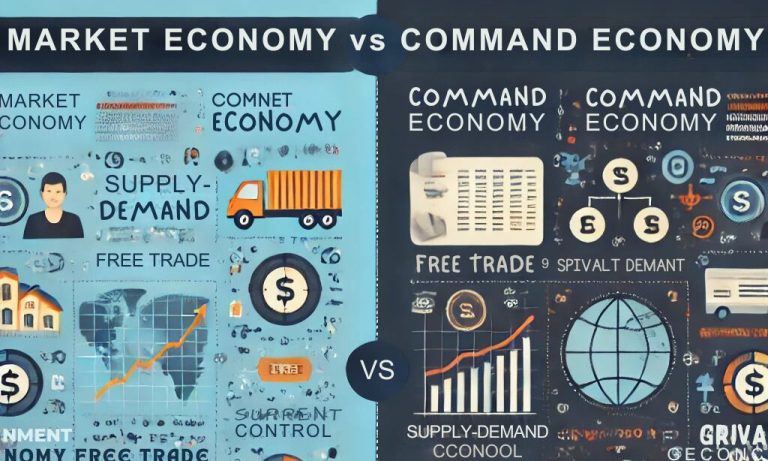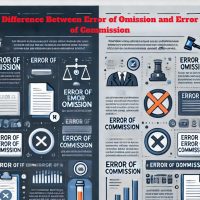The difference between market economy and command economy lies in how resources are allocated and economic decisions are made. A market economy bases production and pricing decisions on free-market forces, relying on supply and demand, while a command economy is controlled by the government, which determines all economic activities. For this reason, knowledge of the two economic systems is important when analyzing how different nations manage resources production, and distribution to achieve economic growth and development.
What is Market Economy?
A market economy is an economic system where decisions regarding investment, production, and distribution are guided by the interplay of supply and demand with minimal government intervention. In this system, businesses and individuals make decisions based on market trends, consumer preferences, and competition.
For example, The United States is a leading example of a market economy where individuals and businesses operate freely, and government intervention is minimal.
Key Features of Market Economy
A market economy thrives on private ownership and the dynamics of supply and demand. It fosters innovation, efficiency, and economic growth through minimal government intervention.
- Private Ownership: Resources and businesses are owned and operated by private individuals or entities.
- Free Market Forces: Prices are determined by supply and demand, reflecting consumer choices and resource availability.
- Profit Motivation: Businesses aim to maximize profits, driving innovation and efficiency.
- Limited Government Intervention: The government’s role is restricted to enforcing laws, protecting property rights, and ensuring fair competition.
What is Command Economy?
A command economy is an economic system where the government has full control over the production, distribution, and pricing of goods and services. Decisions regarding investment, production levels, and resource allocation are made centrally by a governing authority, rather than by market forces.
For example, The Soviet Union under communism and China before economic reforms in the 1980s. Modern: North Korea and Cuba, which still operate under heavy state control.
Key Features of Command Economy
A command economy involves fully planned and regulated resource allocation and all production. These economic systems mainly aim at attaining social objectives through planned policies and regulated pricing.
- Controlled by the Government: The government controls all the resources including land, labor, and capital.
- Fixed Production Aims and Quotas: Authorities set particular production targets and quotas for various industries.
- No Market Competition: Private enterprise is usually absent since the government is the sole decision-maker in the command economy.
- Price Controls: Prices are determined by the state, usually lower than the market price to make them more affordable.
- Social Objectives: Policies are so designed to achieve the social goals of reducing inequality or ensuring universal access to commodities.
Difference Between Market Economy & Command Economy
The market economy vs command economy comparison reveals distinct differences in principles, operations, and outcomes. Here are five key differences:
Ownership
- Market Economy: In a market economy, individuals and private entities own resources and businesses. Ownership remains in the hands of the people, allowing them to manage and profit from their assets. This encourages competition and innovation.
- Command Economy: In a command economy, the government retains ownership of all resources and businesses. The state controls production, distribution, and management, ensuring alignment with national goals rather than individual profits.
Decision-Making
- Market Economy: A market economy relies on decentralized decision-making. Businesses and consumers make choices based on supply and demand dynamics. Producers decide what to make, and consumers decide what to buy, shaping the market organically.
- Command Economy: In a command economy, the government makes centralized decisions. Authorities determine production levels, allocate resources, and set economic priorities, ensuring that activities align with state-defined objectives.
Profit Motive
- Market Economy: Profit serves as the primary driver in a market economy. Businesses focus on earning profits, which motivates innovation, efficiency, and better services. The potential for financial gain spurs competition and economic growth.
- Command Economy: In contrast, a command economy prioritizes social welfare over profit. The government emphasizes equitable distribution of resources and meeting societal needs, often placing less emphasis on profitability and more on collective well-being.
Pricing Mechanism
- Market Economy: Market economies price goods and services by responding to market forces. Supply and demand directly affect the price, so the system is dynamic in terms of consumer behavior and resource availability.
- Command Economy: The government fixes prices in command economies. The government determines price structures and, thus, can make them cheaper and distribute resources without worrying about market fluctuations or consumer preferences.
Economic Role
- Market Economy: Market economies involve limited government intervention. The government typically plays a regulatory role, protecting property rights, enforcing contracts, and addressing market failures without heavily influencing daily economic activities.
- Command Economy: Command economies rely on extensive government control and planning. The state actively directs economic activities, including production, distribution, and pricing, to achieve specific goals such as social equity or industrial development.
| Aspect | Market Economy | Command Economy |
| Ownership | Private ownership of resources and businesses. | Government ownership of resources and businesses. |
| Decision-Making | Decentralized decisions based on supply and demand. | Centralized decisions by the government. |
| Profit Motive | Profit drives business operations and innovation. | Social welfare is prioritized over profit. |
| Pricing Mechanism | Prices are determined by market forces. | Prices are set by the government. |
| Economic Role | Limited government intervention. | Extensive government control and planning. |
Conclusion
The difference between market economy and command economy reflects two opposing approaches to managing economic resources. A market economy thrives on personal freedom, innovation, and competition, while a command economy seeks equality, stability, and centralized power. Most modern economies blend the two approaches to achieve a balance in efficiency and equity, hence the term mixed economy. Understanding these systems allows nations to fashion policies that resonate with their social, economic, and political goals.
Market Economy vs Command Economy FAQs
What is the difference between market economy and command economy?
The market economy depends on free-market forces, while the command economy is controlled centrally by the government.
Which system is good: the market economy or command economy?
Neither is inherently superior; rather, each has its advantages and disadvantages according to a nation’s needs and situation.
What are examples of market and command economies?
The market economy is represented by the United States, while command economy is represented by North Korea.
Determine how pricing differs from market economy vs a command economy
Pricing in a market economy is determined by supply and demand. In a command economy, pricing is determined by the government.
Can an economy combine elements from both systems?
Ideally, many countries adopt a mixed economy, which has features of both market and command economies.


